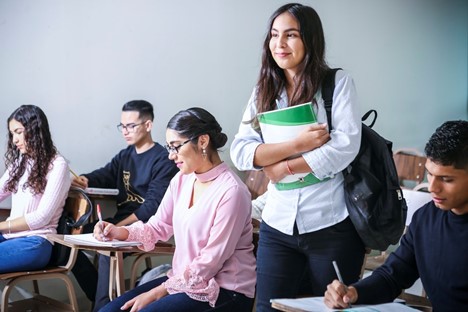
It’s no secret that coronavirus outbreak significantly affected how we offer tuition services. To date, Singapore has recorded 62,470 Coronavirus cases, and the effects are evident across the country.
All is not lost, though. Thanks to the various vaccines available, there is light at the end of the tunnel. As a tutor in Singapore, you need to adhere to the guidelines issued by the Ministry of Education to protect the students and yourself from this deadly virus.
Before we look at the tips on how to continue offering tuition services safely during this pandemic, let us briefly look at the recommendations from MOE published in June 2021.
Safe Distancing

On-premise provision of tuition services is allowed provided there is at least a one-meter distance between the tutor and the student.
In instances where you tutor more than one student at a go, maintain at least a 1-meter distance at all times. No physical interactions should be allowed. Students should not be in groups of more than five. The ministry advises tutors to ensure a 1-2 meter spacing between the groups.
At the same time, this measure will ensure there is enough space between them during the lessons.
Sanitizing Surfaces and Room Ventilation

Covid-19 can stay on surfaces such as desks for more than 24 hours, which poses a risk. Make plans to continuously disinfect the surfaces and shared learning equipment such as microphones and props.
If you are teaching music lessons, sharing brass musical instruments and their respective parts, such as trumpets are prohibited.
The tuition lessons should be held in well-ventilated rooms to promote indoor air quality. Here is a press release on this issue to guide you accordingly.
Wearing of Masks or Face Shields

The tutor and students are required to wear a face shield or face mask. Tutors or students who are feeling unwell should seek immediate medical attention and stay at home.
Let us look at 5 tips to conduct tutoring safely while adhering to the safety guidelines.
1) Set Up Designated Hygiene Stations

This is helpful to not only the students but also you as the tutor. Set up a hygiene station for the student and guests to wash their hands. Washing hands frequently enhance personal hygiene.
If the client does not have one, ask them if you can wash your hands in their bathroom upon arrival. Then, do the same before leaving and use your elbow or a disposable towel to turn off the tap.
2) Adhere to Social Distancing Requirement

Sit at least one meter away from the student. Social distancing lowers the risk of infection and creates a conducive and safe learning environment.
You will both feel at ease and concentrate fully rather than worrying about whether the student is too close. Make the necessary arrangements for this to work well.
For example, think about the books and resources required for each lesson and make sure you always have two copies. It’s okay to request the client to purchase the extra books needed to guarantee maximum safety.
3) Avoid Handshakes and Using the Doorbell

We all love shaking hands as a form of greeting when we meet new clients to establish a personal connection. But, unfortunately, you have to change how you interact with the client during this pandemic.
Thanks to the massive global awareness of how the virus is transmitted, a client is less likely to perceive you as unprofessional when you decline to shake their hand and opt for the “sanitary greeting”. Elbow bumps are a perfect alternative to handshakes.
The doorbells might be touched frequently and by many different people. As mentioned earlier, the virus can remain on surfaces for up to 24 hours. Therefore, it is advisable to avoid pressing the bell, especially if you forgot to carry your antibacterial hand gel.
Consider calling the client to let them know you have arrived. Alternatively, use a knuckle to ring the doorbell. The same case applies to other buttons such as the lift buttons in buildings.
4) Use Your Own Devices

Create an inventory of all the equipment required for all the one-one sessions with the students ahead of time.
Simply put, bringing your own digital devices, paper, pen, and other utilities will give you peace of mind and maintain the highest level of hygiene.
If you have to share some of the items, such as a calculator or iPad, remember to sanitize them before and after the lesson.
5) Explain the Safety Measures to the Student

Don’t assume that the students know how the virus is transmitted and why you made the necessary arrangements. It is not easy to strike a balance between evoking panic and raising awareness about the current situation.
When explaining the safety measures, be careful not to say something that can worry your students. Instead, be aware of the fact that some of them may already be concerned about the pandemic and potential risks.
For example, during a Biology tuition lesson, you can opt to teach them about viruses. You can also discuss the various policies put in place by the government in the Social Studies lessons.
If you provide Economics tuition lesson, then it might a good idea to talking about how the pandemic has affected global economy.
Such is the approach taken by leading provider of JC Economics Tuition in Singapore, Mr Kelvin Hong, who frequently utilises real-world examples to help make economic theories come alive for his students.
Bonus Tip
Write a coronavirus policy memo and send it to all students. They will appreciate your foresight and effort to keep them safe. Regarding the writing style and tone of the memo, be friendly, professional, and open to their suggestions on creating a safe learning space.
In addition, respectfully and politely give details of what the students should do prior to the face-to-face session. For example, you can remind them to postpone classes if they fall sick several days or hours before the lesson.
Remember, your goal as a tutor is to provide an ideal home-based learning environment for the client. Use the above tips to achieve this objective.
Happy tutoring!
